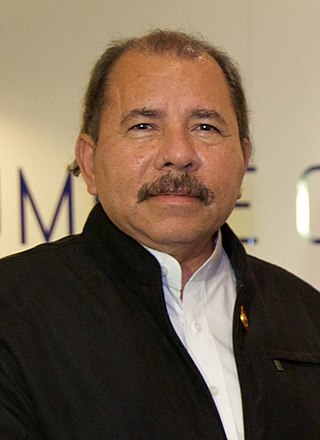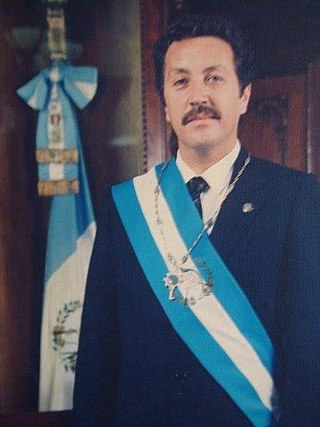
The Contras were the various U.S.-backed and funded right-wing rebel groups that were active from 1979 to 1990 in opposition to the Marxist Sandinista Junta of National Reconstruction Government in Nicaragua, which had come to power in 1979 following the Nicaraguan Revolution. Among the separate contra groups, the Nicaraguan Democratic Force (FDN) emerged as the largest by far. In 1987, virtually all Contra organizations were united, at least nominally, into the Nicaraguan Resistance.

José Daniel Ortega Saavedra is a Nicaraguan politician who has been the 58th President of Nicaragua since 2007. Previously he was leader of Nicaragua from 1979 to 1990, first as Coordinator of the Junta of National Reconstruction from 1979 to 1985, and then as the 54th President from 1985 to 1990. During his first term, he implemented policies to achieve leftist reforms across Nicaragua. In later years, Ortega's left-wing radical politics cooled significantly, leading him to pursue pro-business policies and even rapprochement with the Catholic Church. However, in 2022, Ortega resumed repression of the Church, and has imprisoned prelate Rolando José Álvarez Lagos.
Nicaragua is a nation in Central America. It is located about midway between Mexico and Colombia, bordered by Honduras to the north and Costa Rica to the south. Nicaragua ranges from the Caribbean Sea on the nation's east coast, and the Pacific Ocean bordering the west. Nicaragua also possesses a series of islands and cays located in the Caribbean Sea.

The Sandinista National Liberation Front is a left-wing political party in Nicaragua. Its members are called Sandinistas in both English and Spanish. The party is named after Augusto César Sandino, who led the Nicaraguan resistance against the United States occupation of Nicaragua in the 1930s.

Óscar Arias Sánchez is a Costa Rican activist and Nobel Peace Prize laureate. He was President of Costa Rica from 1986 to 1990 and from 2006 to 2010.

Violeta Barrios Torres de Chamorro is a Nicaraguan former politician who served as President of Nicaragua from 1990 to 1997. She was the first and, to date, only woman to hold the position of president of Nicaragua.

The Contadora Group was an initiative launched in the early 1980s by the foreign ministers of Colombia, Mexico, Panama and Venezuela to deal with the Central American crisis, which were threatening to destabilize the entire Central American region.

The Chapultepec Peace Accords were a set of peace agreements signed on January 16, 1992, the day in which the Salvadoran Civil War ended. The treaty established peace between the Salvadoran government and the Farabundo Martí National Liberation Front (FMLN). It was signed in Chapultepec Castle, Mexico.

The Central American Parliament, also known as PARLACEN, is the political institution and parliamentary body of the Central American Integration System (SICA). Its headquarters are in Guatemala City.

The Nicaraguan Revolution encompassed the rising opposition to the Somoza dictatorship in the 1960s and 1970s, the campaign led by the Sandinista National Liberation Front (FSLN) to oust the dictatorship in 1978–79, the subsequent efforts of the FSLN to govern Nicaragua from 1979 to 1990, and the Contra War, which was waged between the FSLN-led government of Nicaragua and the United States–backed Contras from 1981 to 1990. The revolution marked a significant period in the history of Nicaragua and revealed the country as one of the major proxy war battlegrounds of the Cold War, attracting much international attention.

Marco Vinicio Cerezo Arévalo is a Guatemalan politician who served as the 40th president of Guatemala from 1986 to 1991. He also served as the Secretary General of the Central American Integration System (SICA) from 2017 to 2021.

General elections were held in Costa Rica on 5 February 2006. In the presidential election, Óscar Arias of the National Liberation Party, a former president and Nobel Peace Laureate, was victorious over Ottón Solís of the Citizens' Action Party and twelve other minor-party candidates. Although Arias was expected to win by a wide margin, the actual polling reports were unexpectedly close. However, early results showed the contest to be closer than it actually was. The preliminary official report, after 88.45% of the vote counted, showed the result for President of the Republic almost tied between Arias with 40.51% of the vote and Ottón Solís with 40.29%. Given the small difference of only 3250 votes, the Superior Electoral Tribunal announced that a manual count of all the votes would start immediately and no official winner would be announced until that process was completed, approximately two weeks after the election.
William Chester Goodfellow is the director of the Afghanistan Peace Campaign, which builds public support for an enduring peace settlement that will end the war, bring U.S. troops home and promote national reconciliation in Afghanistan. Goodfellow has made numerous trips to Kabul to interview Afghan government officials, activists, and academics. In op-ed articles, he has argued that successful implementation of a peace agreement in Afghanistan could serve as a template for resolving other seemingly-intractable conflicts in the Middle East and northern Africa.
Confidence-building measures (CBMs) were a key element in the Central American peace process. Although CBMs have always existed in some form or another in the hemisphere's conflict situations, the Central American peace process for the first time in a Latin American conflict explicitly used CBM terminology and techniques. This was no accident, and reflected the key role played by the UN and by certain outside actors in bringing these ideas to the peace process.
The Central American crisis began in the late 1970s, when major civil wars and communist revolutions erupted in various countries in Central America, causing it to become the world's most volatile region in terms of socioeconomic change. In particular, the United States feared that victories by communist forces would cause South America to become isolated from the United States if the governments of the Central American countries were overthrown and pro-Soviet communist governments were installed in their place. During these civil wars, the United States pursued its interests by supporting right-wing governments against left-wing guerrillas.
Operation Charly, was allegedly the code-name given to a program during the 1970s and 1980s undertaken by the junta in Argentina with the objective of providing military and counterinsurgency assistance to right-wing dictatorships and insurgents in Central America. According to Noam Chomsky, the operation was either headed by the Argentine military with the agreement of the United States Department of Defense, or was led by the US and used the Argentinians as a proxy.
The modern history of Honduras is replete with large-scale disappearances of left-leaning union members, students and others. The legislature approved a new constitution in 1982, and the Liberal Party government of President Roberto Suazo Córdova took office. Suazo relied on United States support — including controversial social and economic development projects sponsored by the United States Agency for International Development — during a severe economic recession. According to the US State Department, "Honduras became host to the largest Peace Corps mission in the world, and non-governmental and international voluntary agencies proliferated."

General elections were held in Nicaragua on 4 November 1984, to elect a president and parliament. Approximately 1.2 million Nicaraguans voted, representing a 75% turnout, with 94% of eligible voters registered. Impartial observers from international groupings such as the European Economic Community, religious groups sent to monitor the election, and observers from democratic nations such as Canada and Ireland concluded that the elections were generally free and fair.

The nations of Costa Rica and Mexico established diplomatic relations 1838. Both nations are members of the Association of Caribbean States, Community of Latin American and Caribbean States, Organization of American States, Organization of Ibero-American States and the United Nations.
The Guatemalan Peace Process was a series of negotiations occurring from 1994 to 1996, to resolve the Guatemalan Civil War.












